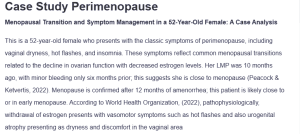Case Study Perimenopause
Menopausal Transition and Symptom Management in a 52-Year-Old Female: A Case Analysis
This is a 52-year-old female who presents with the classic symptoms of perimenopause, including vaginal dryness, hot flashes, and insomnia. These symptoms reflect common menopausal transitions related to the decline in ovarian function with decreased estrogen levels. Her LMP was 10 months ago, with minor bleeding only six months prior; this suggests she is close to menopause (Peacock & Ketvertis, 2022). Menopause is confirmed after 12 months of amenorrhea; this patient is likely close to or in early menopause. According to World Health Organization, (2022), pathophysiologically, withdrawal of estrogen presents with vasomotor symptoms such as hot flashes and also urogenital atrophy presenting as dryness and discomfort in the vaginal area
Both race and ethnicity can affect the symptomatology and the timing of menopause. For instance, most studies reported that African American women tend to have worse hot flashes and night sweats compared to the rest of the ethnic groups. In contrast, Asian women generally have fewer vasomotor symptoms. Such variables must be considered in culturally sensitive care and for accuracy in symptom interpretation (Harlow et al., 2022).The characteristic features of the patient, including age and family history, provide the basis for the menopausal status of the patient. In this patient, her age and her mother having reached menopause at age 48 indicate a genetically determined trend in her menopausal transition. She also has a high-normal blood pressure of 134/78 mmHg and needs follow-up. According to Ryczkowska et al. (2022), menopause contributes to cardiovascular risk because estrogen, which earlier had provided protective effects, becomes very low.
The most common way that STDs affect fertility is through any type of infection that could progress into PID, such as chlamydia and gonorrhea (Jennings & Krywko, 2023). This may cause inflammation, scarring, and possibly blockage of the fallopian tubes, complicating conception and increasing the risks of ectopic pregnancy. Mediated by the inflammatory response to STDs and PID, inflammatory markers and WBCs rise due to cytokines released by immune cells attempting to clear the infection, resulting in inflammation and destruction of tissue in more advanced stages (Mwatelah et al., 2019).
Further, prostatitis is usually caused by bacterial invasion through the urinary tract or rectum and may result in prostate inflammation. Chronic prostatitis can result from immune responses, neurogenic problems, or muscle problems. Systemic responses to infection are caused by the action of the immune cells releasing cytokines like IL-1 and TNF-alpha, bacterial toxins, and possibly the development of sepsis in cases where the pathogen has gained entry into the bloodstream, and this causes generalized inflammation with damage to organs.
In conclusion, the patient is likely to be peri- or early menopausal, as her symptoms and recent menstrual history indicate; the decline in estrogen contributes to vasomotor symptoms and urogenital atrophy. Her background, including family history and ethnicity, underlines specific factors that will have a bearing on her menopausal profile, while the withdrawal of estrogen increases her cardiovascular risk. Apart from this, untreated infections such as STDs can lead to severe reproductive and systemic complications; hence, the importance of early treatment and management of infective and menopausal conditions.
References
Harlow, S. D., Burnett-Bowie, S.-A. M., Greendale, G. A., Avis, N. E., Reeves, A. N., Richards, T. R., & Lewis, T. T. (2022). Disparities in reproductive aging and midlife health between black and white women: The Study of Women’s Health Across the Nation (SWAN). Women’s Midlife Health, 8(1). https://doi.org/10.1186/s40695-022-00073-y
Jennings, L. K., & Krywko, D. M. (2023, March 13). Pelvic inflammatory disease. National Library of Medicine; StatPearls Publishing. https://www.ncbi.nlm.nih.gov/books/NBK499959/
Mwatelah, R., McKinnon, L. R., Baxter, C., Abdool Karim, Q., & Abdool Karim, S. S. (2019). Mechanisms of sexually transmitted infection‐induced inflammation in women: Implications for HIV risk. Journal of the International AIDS Society, 22(S6). https://doi.org/10.1002/jia2.25346
Peacock, K., & Ketvertis, K. M. (2022). Menopause. NIH; StatPearls Publishing. https://www.ncbi.nlm.nih.gov/books/NBK507826/
Ryczkowska, K., Adach, W., Janikowski, K., Banach, M., & Bielecka-Dabrowa, A. (2022). Menopause and women’s cardiovascular health: Is it really an obvious relationship? Archives of Medical Science, 19(2), 458–466. https://doi.org/10.5114/aoms/157308
World Health Organization. (2022, October 17). Menopause. World Health Organization. https://www.who.int/news-room/fact-sheets/detail/menopause
ORDER A PLAGIARISM-FREE PAPER HERE
We’ll write everything from scratch
Question
Case study #10
Case Scenario:
- Patient is a 52-year-old female who presents to the clinic with complaints of vaginal dryness, hot flashes, and insomnia worsening over the last few months. Her LMP was 10 months ago but she did notice some minor menstrual bleeding about 6 months ago but nothing since. Her mother’s menopause happened at 48 years old. Patient denies any other symptoms. BP 134/78, pulse 80, temp 98.4, oxygen sat 96%.
Case Study Perimenopause
Students will:
- Analyze concepts and principles of pathophysiology related to women’s and men’s health across the lifespan
- Identify racial/ethnic variables that may impact physiological functioning
- Evaluate the impact of patient characteristics on disorders and altered physiology
Resource:
- McCance, K. L. & Huether, S. E. (2019). Pathophysiology: The biologic basis for disease in adults and children (8th ed.). St. Louis, MO: Mosby/Elsevier.


